Motivated in May
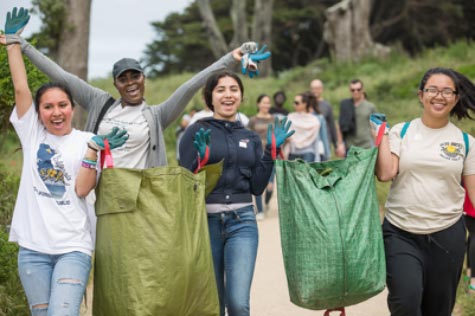
Photo by Maria Durana
My, oh, my, this year is flying by! As the days get warmer and the wildflowers bloom in abundance, the San Francisco Park Stewardship Team continues to tackle those invasive weeds.
Many, many thanks to those who joined us in our appreciation of this beautiful planet during our Earth Day celebration. With over 150 volunteers participating at Lands End, we barely have any weeds left to pull!
But have no fear! There is always a way we can help. Whether it is through the removal of exotic weeds or by taking part in one of our wildflower walks, you will always be warmly embraced by the Golden Gate National Parks! Hope to see you out there!
Wildflower Walks
It’s springtime, and all throughout California, the wildflowers are beginning to bloom, including in your very own Golden Gate National Parks. Come join us to see the huge variety of wildflowers on display and prepare to be wowed by the range of colors, shapes, and scents!
The Park Stewardship team will lead easy walks along your park trails to highlight the folklore, medicinal properties, and ecological and restoration uses of your favorite flowers. Spectacular views of the Pacific Ocean and a new appreciation for spring wildflowers in San Francisco are guaranteed!
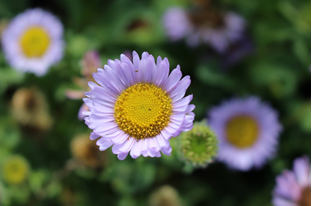
|
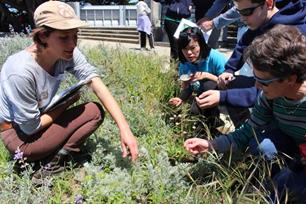 |
| Photo by Yakuta Poonawalla |
Photo by Alisa Kim |
Fort Funston: Saturday, 5/6 and 6/10; 10 AM–Noon
Lands End: Saturday, 5/20; 10 AM–Noon
If you are interested in joining any of these dates, please register at the links provided above, or feel free to contact Yakuta Poonawalla at ypoonawalla@parksconservancy.org to schedule your own group of 5–10 people for a wildflower walk during the week!
Announcements
Come join the Friends of the Golden Gate (the Parks Conservancy’s young professionals group) at El Polín spring for a trail mixer! Hosted on May 4 from 6–8 pm enjoy yoga, beer from Fort Point Beer Co., snacks from Whole Foods, and a beautiful national park site! See here for more information.
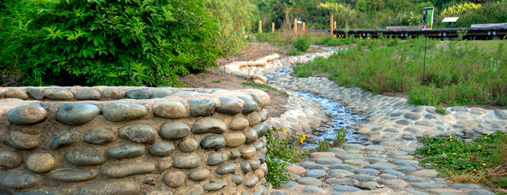
Parks Conservancy stock photo
A new exhibition is open now at the Presidio Officers’ Club. The exhibit, titled Exclusion, invites visitors to explore the Presidio’s role in the unjust mass incarceration of Japanese Americans during World War II. Discover the political and personal decisions that led to the breach of their civil liberties, and experience what the incarcerated Japanese Americans felt during this dark episode in America’s past. Learn more here.
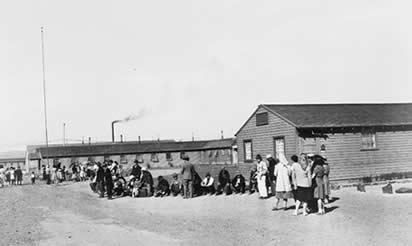
National Park Service stock photo
Come out to the Fort Baker pier on May 13 from 10 am to noon and catch crabs, while learning about the history of crabbing in the Bay Area. If your catch is legal, you can take it to enjoy that night for dinner! See here for reservation information.
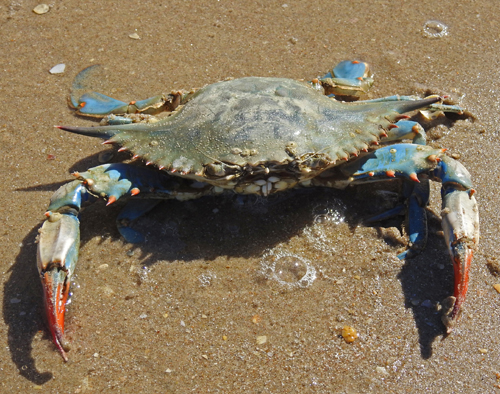
National Park Service stock photo
Come to Milagra Ridge on May 14 from noon to 2 pm and learn about the military and natural history of this beautiful park site. Nike veteran David Bridgman will lead a leisurely hike along the former gun and Nike missile site, which is now the protected home for the federally endangered mission blue butterfly. See here for reservation information.
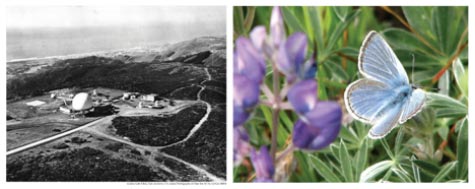
National Park Service stock photo
A Strawberry’s Path
By Nick Regent
Ecological Restoration and Volunteer Management Intern
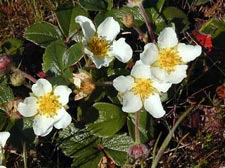 |
| National Park Service stock photo |
With summer right around the corner, and many flowers in full bloom, we can soon expect to see many types of fruits in our park! Few, however, invoke as much excitement and joy as the appearance of ripe native strawberries. These berries have a significant and fascinating history, because they are a direct ancestor to the strawberries we buy off store shelves today.
Our native coastal strawberry, known also as Fragaria chiloensis, was a food source for many of the Native American tribes that lived on and with these lands for thousands of years. They looked forward to the yearly arrival of the delicious fleshy berries, as this species of strawberry is particularly sweet and juicy. F. chiloensis was also a great food source for small mammals and birds, and it is thought that migrating birds carried the seeds down to the coast of Chile, where the name of this plant originates from. Once in Chile, the Picunche and Mapuche natives began to cultivate the strawberry.
Different species of strawberry were also popular in parts of Europe, as the French had begun to transplant the wood strawberry, Fragaria vesca, from the wild into their gardens beginning in the 1300s. By the 1600s another European species of strawberry, Fragaria moschata, had gone into cultivation and the North American species Fragaria virginiana, found in eastern America, had been brought back from the New World to be added to European stock. This American species was hardier, but remained unappreciated until the early 1800s when botanists began to take notice of its qualities.
When the Spanish invaded South America in the 1500s, they found lots of the F. chiloensis strawberry in cultivation in native gardens, and considered them a great victory bounty. The conquerors moved further into South America and took the strawberry with them, setting up cultivation plots on a slightly larger scale. Though they noted the great size and taste of these berries to their homeland, as did explorers to the South American coast, it wasn’t until 1712 that a French engineer in the army brought this particular species back to Europe.
Amedee Francois Frezier was a member of the French Army Intelligence Corps, sent to the Spanish territories of Chile and Peru by King Louis XIV who was determined to keep his grandson, the King of Spain, on the throne as long as possible and therefore had to know as much about the Spanish empire as he could. On his reconnaissance tour Frezier collected samples of the large F. chiloensis plants he saw and nursed them on the long six-month voyage home. Planted in gardens in France, the first cross between F. chiloensis and F. virginiana occurred in Brittany, France in 1750, and the resulting hybrid was one of great hardiness, taste, and quantity.
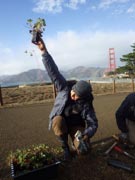 |
| National Park Service stock photo |
This new hybrid species was then bred and selected many times for certain qualities, crossed again with the parent species, until eventually the strawberry we know today was created. The hybrid then made its way back to the New World and by the 1800s strawberries were grown as a crop on a commercial scale.
Today California is the leading grower of strawberries worldwide, and it’s all due to a native species that exists throughout the Golden Gate National Parks. Just a great example of the incredible stories these plants can tell!
P.S. The part of the strawberry that we eat and consider the fruit is not actually a fruit in botanical terms. Instead, the small seed-like structures dotting the fleshy berry are called achenes, and they house the real seeds. The rest of the berry is simply the receptacle that holds the ovaries.
Whale, Whale, Whale. What Do We Have Here?
By Katie Fitzgerald
Ecological Restoration and Volunteer Management Academic Intern
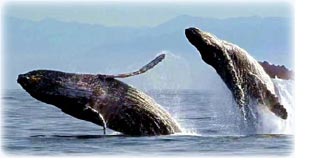 |
| Photo by M. A. Gallardo |
A couple of weeks ago, during one of the restoration programs at Lands End, I witnessed many curious gazes looking out toward the ocean. I did what many of us would have done; I joined the crowd of onlookers and was awestruck by what I saw, whales sticking their heads up straight out of the water in an act referred to as spy-hopping. Being so far away, I couldn’t make out the details of their appearances but my mind quickly painted a picture that reflected the images I have seen on nature documentaries.
It was hard for me to peel my eyes away and get back to leading the wonderful volunteers, but I had a mission that needed to be fulfilled. That week I kept replaying the image of those rollicking whales and wondered what secrets they hold living in a world that is completely alien to me. Maybe it was kismet, or maybe it’s just one of those things, but I came across an article that revealed the value of whales in combating climate change.
In their environment, whales are up there at the top of the food chain with a diet consisting of fish and krill. Considering how large whales are and how much they eat, some politicians have argued that participating in commercial whaling actually benefits humans. Their stance is that reducing the numbers of whales would mean lessening the competition that would result in greater numbers of fish for mankind. However, as the great whales’ populations declined, so did the fish and krill.
It turns out that whales play a vital role in the oceans’ ecosystems. Whales often feed in depths of water that are dark and do not receive much sunlight. As they surface back up to the top of the ocean where there is plenty of light, known as the photic zone, they release their fecal matter in vast amounts which acts as fertilizer for phytoplankton. Whales’ fecal matter contains nutrients that are often scarce in the surface waters. As the whales plunge down and feed in the deep ocean waters and then return these nutrients to the surface waters, they are also mixing and resurfacing the plankton, assisting in the continuation of plankton reproduction.
So what is so important about increasing phytoplankton? Plankton is the foundation of the food chain in the oceans that many of our marine animals depend on for survival. Taking away whales means less fertilized phytoplankton, less phytoplankton being upwelled, less food for many species of organisms in the ocean, and inevitably, less fish available for consumption.
How is this relevant to climate change? Phytoplankton are plants of the ocean that rely on carbon dioxide to perform photosynthesis. These plants of the ocean (plankton) can absorb a lot of carbon that will either be consumed and give nutrients to other marine organisms, or fall to the ocean floor. Those that fall to the floor carry with them the carbon they have absorbed, thus removing carbon molecules from circulating in the atmosphere. To recap, the more whales there are, the more plankton there is; the more plankton there is, the more carbon is being sequestered out of the atmosphere.
Whales are just one example of the interconnected significance of an organism to the planet’s delicate ecosystems. I suppose some of us humans figure that since we are gifted with the brains that we have that we are the most important and the most capable. After researching how whales affect the climate and fish populations, I started to review my own work in restoration and how I may be setting the stage for biotic wonders that may be sustaining the world in ways I never imagined. We are great, and we are capable, but this is a great big world that has many participants contributing to the health of this planet and we need them. As much as you may all have heard this, I must leave you all with this quote.
“Humankind has not woven the web of life. We are but one thread within it. Whatever we do to the web, we do to ourselves. All things are bound together. All things connect.” – Chief Seattle
Highlights from the Field: April-May
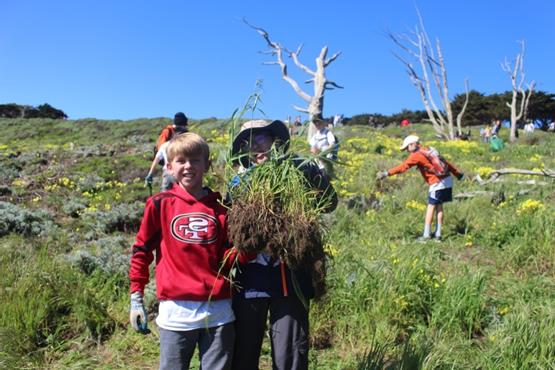
Photo by Nick Regent
Presidio Coastal Bluffs
- 17 bags of exotic plants removed!
Lands End
- 304 huge bags of annual grasses pulled
- 5 gray whale sightings!
Fort Funston
- 123 bags full of weeds cleared
- 64 student volunteers!
Check out our Flickr page for pictures from volunteer workdays!
Drop-In Volunteer Programs
|
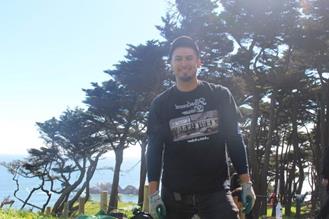
Photo by Tanya Vincent
Volunteer on Thursdays:
Presidio Coastal Bluffs, 1–4 pm
May 18
Lobos Creek, 1–4 pm
May 25
Canceled: May 4 and 11
|
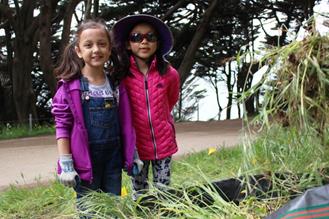
Photo by Yakuta Poonawalla
Volunteer on Saturdays:
Lands End, 1–4 PM
May 6, 13, 20
Canceled: May 27
|
Click here to find our volunteer workday schedule.
|
See you in the field!

|